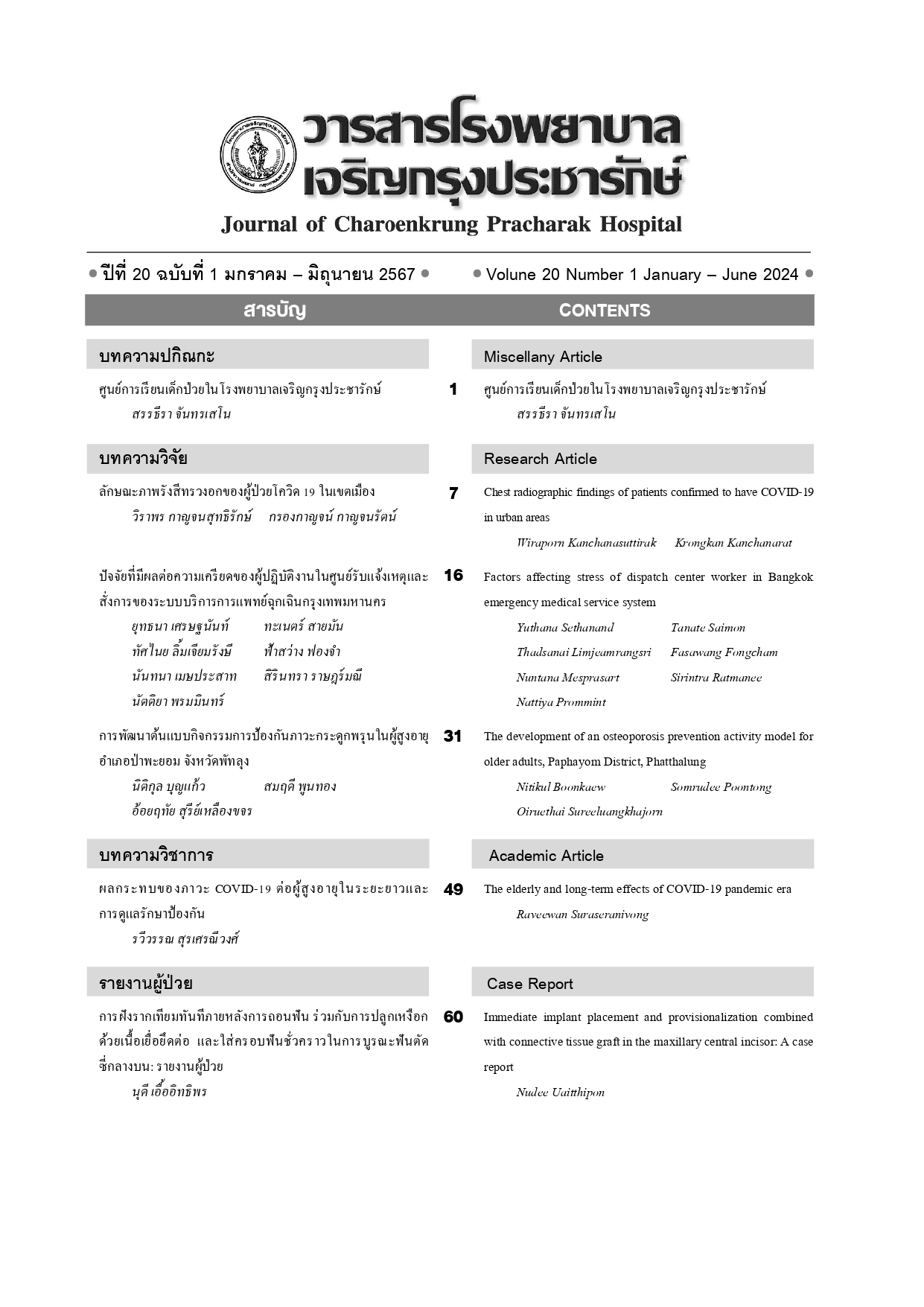ผลกระทบของภาวะ COVID-19 ต่อผู้สูงอายุในระยะยาวและการดูแลรักษาป้องกัน
Main Article Content
บทคัดย่อ
บทนำ: ในช่วงระยะ 2-3 ปีที่ผ่านที่มีการระบาดของ SARS-COV-2 หรือ COVID-19 การติดเชื้อก่อให้เกิดการระบาดไปทั่วโลก เกิดการเปลี่ยนแปลงครั้งยิ่งใหญ่ทั้งในแง่สุขภาพ การสาธารณสุข เศรษฐกิจ และสังคม และ ในปี 2565 นี้ประเทศไทยกำลังเข้าสู่สังคมผู้สูงอายุซึ่งมีจำนวนเข้าใกล้ร้อยละ 20 ของประชากรทั้งหมดจึงจำเป็นต้องเรียนรู้ว่า การระบาดนี้มีผลต่อผู้สูงอายุอย่างไร
วัตถุประสงค์: เพื่อรวบรวมข้อมูลและนำเสนอปัญหาที่เกิดกับผู้สูงอายุที่เกิดจากการระบาด COVID-19 ทั้งในทางตรงและทางอ้อม ในแง่ทางร่างกาย จิตใจ และสังคม เพื่อนำไปสู่การแก้ปัญหาและป้องกันปัญหาแทรกซ้อนที่จะเกิดขึ้นต่อไป
วิธีการดำเนินการศึกษา: สืบค้นเพื่อรวบรวมข้อมูลจากงานวิจัยต่าง ๆ ในฐานข้อมูลวิชาการทั้งในประเทศและต่างประเทศที่ได้รับการยอมรับ เรียบเรียงเนื้อหาเพื่อนำเสนอในแต่ละด้าน
ผลการศึกษา: ผู้สูงอายุที่ติดเชื้อ COVID-19 จะอัตราการเกิดภาวะทุพพลภาพและอัตราการเสียชีวิตที่สูงกว่าบุคคลทั่วไป โดยเฉพาะผู้สูงอายุที่มีอายุมากกว่า 80 ปี จะพบอัตราการเสียชีวิตสูงถึงร้อยละ 20 ปัจจุบันประเทศไทยเข้าสู่สังคมผู้สูงอายุเต็มรูปแบบซึ่งหมายถึงจะมีผู้ที่อายุมากกว่า 65 ปี มากกว่าร้อยละ 20 ในสังคม ดังนั้นบุคลากรทางสาธารณสุขในประเทศไทยจึงควรรู้จักเกี่ยวกับผลกระทบระยะยาวจากการติดเชื้อ COVID-19 หรือเรียกว่า “Long COVID syndrome” นอกเหนือจากนั้นยังควรต้องทราบปัญหาที่อาจซุกซ่อนอยู่หรือถูกมองข้ามซึ่งเกิดได้บ่อยในผู้ป่วยสูงอายุ เช่น ภาวะสับสนเฉียบพลัน (delirium) ภาวะสมองเสื่อม (dementia) หรือโรคเครียดภายหลังเผชิญเหตุการณ์สะเทือนขวัญ (post traumatic stress disorder) เป็นต้น ในแง่ผลกระทบทางสังคมผู้สูงอายุอาจไม่ได้รับผลกระทบโดยตรงแต่ได้รับผลกระทบทางอ้อมจากการที่ลูกหลานต้องเปลี่ยนงานหรือตกงานทำให้เศรษฐฐานะแย่ลงจากมาตรการปิดเมือง
สรุป: การระบาดของ COVID-19 ส่งผลกระทบไม่เพียงแค่บุคคลทั่วไป แต่ส่งผลต่อผู้สูงอายุในหลายด้านทั้งด้านร่างกาย สติปัญญา จิตใจ และสังคม ซึ่งเป็นสิ่งที่ควรตระหนักและป้องกันไม่ให้เกิดปัญหาจนเกิดความพิการหรือการเสียชีวิตตามมา การได้รับการวินิจฉัยหรือตรวจพบปัญหาตั้งแต่เบื้องต้นและได้รับการป้องกันรักษาอย่างทันท่วงทีจะช่วยพัฒนาคุณภาพชีวิตของผู้สูงอายุได้
Article Details

อนุญาตภายใต้เงื่อนไข Creative Commons Attribution-NonCommercial-NoDerivatives 4.0 International License.
เอกสารอ้างอิง
Tosato M, Carfì A, Martis I, Pais C, Ciciarello F, Rota E, et al. Prevalence and predictors of persistence of COVID-19 symptoms in older adults: a single-center study. J Am Med Dir Assoc 2021;22(9):1840-4.
Recinella G, Marasco G, Battista AD, Bianchi G, Zoli M. Prognostic role of nutritional status in elderly patients hospitalized for COVID-19: a monocentric study. Aging Clin Exp Res 2020; 32(12):2695-701.
กองทุนสนับสนุนสร้างเสริมสุขภาพ(สสส.). การเผชิญหน้า-‘สังคมผู้สูงอายุ’-โจทย์ท้าทายภาระค่าใช้จ่ายที่เพิ่มขึ้น [อินเทอร์เน็ต]. 2565 [เข้าถึงเมื่อ 6 มิ.ย. 2566]. เข้าถึงได้จาก: https://resourcecenter.thaihealth.or.th/article/
Guo J, Wei X, Li Q, Li L, Yang Z, Shi Y, et al. Single‐cell RNA analysis on ACE2 expression provides insights into SARS‐CoV‐2 potential entry into the bloodstream and heart injury. J Cell Physiol 2020; 235(12):9884-94.
Dayaramani C, D Leon J, Reiss AB. Cardiovascular disease complicating COVID-19 in the elderly. Medicina 2021;57(8):833.
Puntmann VO, Carerj ML, Wieters I, Fahim M, Arendt C, Hoffmann J, et al. Outcomes of cardiovascular magnetic resonance imaging in patients recently recovered from coronavirus disease 2019 (COVID-19). JAMA cardiol 2020;5(11):1265-73.
Kalra RS, Dhanjal JK, Meena AS, Kalel VC, Dahiya S, Singh B, et al. COVID-19, neuropathology, and aging: SARS-CoV-2 neurological infection, mechanism, and associated complications. Front Aging Neurosci 2021;13:662786.
Yang K, Wen G, Wang J, Zhou S, Da W, Meng Y, et al. Complication and sequelae of COVID-19: what should we pay attention to in the post-epidemic era. Front Immunol 2021;12:711741.
Fung KW, Baye F, Baik SH, Zheng Z, McDonald CJ. Prevalence and characteristics of long COVID in elderly patients: an observational cohort study of over 2 million adults in the US. PLoS Med 2023;20(4): e1004194.
Michelen M, Manoharan L, Elkheir N, Cheng V, Dagens A, Hastie C, et al. Characterising long COVID: a living systematic review. BMJ glob health 2021;6(9):e005427.
Drey M. Pfeifer K, Sieber CC, Bauer JM, The Fried frailty criteria as inclusion criteria for a randomized controlled trial: personal experience and literature review. Gerontology 2011;57(1):11-8.
Bielza R, Sanz J, Zambrana F, Arias E, Malmierca E, Portillo L, et al. Clinical characteristics, frailty, and mortality of residents with COVID-19 in nursing homes of a region of Madrid. J Am Med Dir Assoc 2021; 22(2):245-52.
Pizano-Escalante MG, Anaya-Esparza LM, Nuño K, Rodríguez-Romero JJ, Gonzalez-Torres S, López-de la Mora DA, et al. Direct and indirect effects of COVID-19 in frail elderly: interventions and recommendations. J Pers Med 2021;11(10):999.
Mendes A, Herrmann FR, Périvier S, Gold G, Graf CE, Zekry D. Delirium in older patients with COVID-19: prevalence, risk factors, and clinical relevance. J Gerontol A Biol Sci Med Sc 2021;76(8):e142-6.
Mcloughlin BC, Miles A, Webb TE, Knopp P, Eyres C, Fabbri A, et al. Functional and cognitive outcomes after COVID-19 delirium. Eur Geriatr Med 2020;11(5):857-62.
O’Hanlon S, Inouye SK. Delirium: a missing piece in the COVID-19 pandemic puzzle. Age Ageing 2020; 49(4):497-8.
Bakker ED, van de Pas SL, Zwan MD, Gillissen F, Bouwman FH, Scheltens P, et al. Steeper memory decline after COVID-19 lockdown measures. Alzheimers Res Ther 2023;15(1):1-9.
Simonetti A, Pais C, Jones M, Cipriani MC, Janiri D, Monti L, et al. Neuropsychiatric symptoms in elderly with dementia during COVID-19 pandemic: definition, treatment, and future directions. Front psychiatry 2020; 11:579842.
Numbers K, Brodaty H. The effects of the COVID-19 pandemic on people with dementia. Nat Rev Neurol 2021;17(2):69-70.
Cagnin A, Lorenzo RD, Marra C, Bonanni L, Cupidi C, Lagana V, et al. Behavioral and psychological effects of coronavirus disease-19 quarantine in patients with dementia. Front psychiatry 2020;11:578015.
Sciacqua A, Pujia R, Arturi F, Hribal ML, Montalcini T. COVID-19 and elderly: beyond the respiratory drama. Intern Emerg Med 2020;15(5):907-9.
Aguiar GB, Dourado KF, Andrade MIS, Domingos Júnior IR, Barros-Neto JA, Vasconcelos SML, et al. Frequency and factors associated with sarcopenia prediction in adult and elderly patients hospitalized for COVID-19. Exp Gerontol 2022;168:111945.
Abdelbasset WK. Stay Home: Role of physical exercise training in elderly individuals’ ability to face the covid-19 infection [Internet]. 2020 [Cited 2023 Jun 6]. Available from: https://pubmed.ncbi.nlm.nih.gov/33354578/ psychological
Lee K, Jeong GC, Yim J. Consideration of the and mental health of the elderly during COVID-19: A theoretical review. Int J Environ Res Public Health 2020;17(21):8098.
อรัญญา ตุ้ยคัมภีร์. ความ สัมพันธ์ ระหว่าง สุข ภาวะ ทาง สังคม และ ปัญหา สุขภาพ จิต ของ ผู้ สูงอายุ ใน ช่วง สถานการณ์ การ แพร่ ระบาด ของ โค วิด 19. วารสารศึกษาศาสตร์ มสธ. มหาวิทยาลัยสุโขทัยธรรมาธิราช2022;15(2):133-46.
ภาคิน โชติเวศย์ศิลป์. ความมั่นคงระหว่างประเทศภายหลังการระบาด COVID-19. วารสารนาคบุตรปริทรรศน์ 2022;14(1):132-45.
Martins Van Jaarsveld G. The effects of COVID-19 among the elderly population: a case for closing the digital divide. Front Psychiatry 2020;11:1211.


